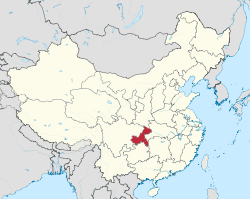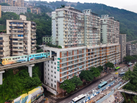
Back Chongqing ACE Chongqing Afrikaans ቾንግጪንግ Amharic Chongqing AN تشونغتشينغ Arabic تشونجتشينج ARZ Chongqing AST Çuntsin Azerbaijani Чунцин Bashkir Chongqing BAN
Chongqing
重庆 Chungking | |
|---|---|
 | |
 Location of Chongqing Municipality within China | |
| Coordinates (Chongqing municipal government): 29°33′49″N 106°33′01″E / 29.5637°N 106.5504°E | |
| Country | China |
| Settled | c. 316 BC |
| Separated from Sichuan | 14 March 1997 |
| Municipal seat | Yuzhong District |
| Divisions - County-level - Township-level | 26 districts, 12 counties |
| Government | |
| • Type | Municipality |
| • Body | Chongqing Municipal People's Congress |
| • Party Secretary | Yuan Jiajun |
| • Congress Chairperson | Wang Jiong |
| • Mayor | Hu Henghua |
| • Municipal CPPCC Chairperson | Cheng Lihua |
| • National People's Congress Representation | 58 deputies |
| Area | |
• Municipality | 82,403 km2 (31,816 sq mi) |
| • Built up area | 5,472.8 km2 (2,113.1 sq mi) |
| Elevation | 244 m (801 ft) |
| Highest elevation | 2,797 m (9,177 ft) |
| Population (2020 census (total), 2018 (otherwise))[4] | |
• Municipality | 32,054,159 |
| • Density | 390/km2 (1,000/sq mi) |
| • Urban | 22,251,500[note 1][2] |
| • Built up area | 9,580,770[3] |
| GDP(2023) [5] | |
| • Municipality | CN¥ 3,015 billion (17th) US$ 428 billion |
| • Per capita | CN¥ 94,135 (10th) US$ 13,359 |
| Time zone | UTC+8 (CST) |
| Postal codes | 4000 00 – 4099 00 |
| Area code | 23 |
| ISO 3166 code | CN-CQ |
| – Growth | |
| Abbreviation | CQ / 渝; Yú |
| Climate | Cfa |
| HDI (2022) | 0.795[6] (9th) – high |
| Website |
|
| Symbols | |
| Flower | Camellia japonica[7] |
| Tree | Ficus lacor[8] |
| Chongqing | |||||||||||||||||||||||||||||||||||||||||||
|---|---|---|---|---|---|---|---|---|---|---|---|---|---|---|---|---|---|---|---|---|---|---|---|---|---|---|---|---|---|---|---|---|---|---|---|---|---|---|---|---|---|---|---|
 "Chongqing" in Simplified (top) and Traditional (bottom) Chinese characters | |||||||||||||||||||||||||||||||||||||||||||
| Simplified Chinese | 重庆 | ||||||||||||||||||||||||||||||||||||||||||
| Traditional Chinese | 重慶 | ||||||||||||||||||||||||||||||||||||||||||
| Postal | Chungking | ||||||||||||||||||||||||||||||||||||||||||
| Literal meaning | "Doubled Celebration" | ||||||||||||||||||||||||||||||||||||||||||
| |||||||||||||||||||||||||||||||||||||||||||
Chongqing[a] is a direct-administered municipality in Southwestern China. Chongqing is one of the four direct-administered municipalities under the Central People's Government, along with Beijing, Shanghai, and Tianjin. It is the only directly administrated municipality located deep inland.[13] The municipality covers a large geographical area roughly the size of Austria,[14] which includes several disjunct urban areas in addition to Chongqing proper. Due to its classification, the municipality of Chongqing is the largest city proper in the world by population, though Chongqing is not the most populous urban area.
The municipality of Chongqing is the only Chinese municipality with a resident population of over 30 million;[15] however, this number includes its large rural population.[16] In 2020, Chongqing surpassed Shanghai as China's largest municipality by urban population; as of 2022[update], it has an urban population of 22.8 million.[15] The municipality contains 26 districts, 8 counties, and 4 autonomous counties. The city served as the wartime capital for the Republic of China (ROC) during the Second Sino-Japanese War (1937–1945). On 14 March 1997, the current municipality was separated from the surrounding province of Sichuan, with the goal of furthering development in the central and western parts of the country.[17] University of Washington professor Kam Wing Chan argued that Chongqing's status is more akin to that of a province rather than a city.[14]
As one of China's National Central Cities, Chongqing serves as a center for finance in the Sichuan Basin and the upstream Yangtze, as well as for manufacturing and transportation. It is a connection in the Yangtze River Economic Belt and a base for the country's Belt and Road Initiative.[18] Chongqing Jiangbei International Airport is the second-busiest airport in China, and is one of the top 50 busiest airports in the world.[19][20] The city's monorail system is the world's longest and busiest, as well as having the greatest number of stations, with 70.[21][22] Chongqing is ranked as a Beta (global second-tier) city.[23] It is the headquarters of the Changan Automobile, one of the "Big Four" car manufacturers of China.[24] As of 2023[update], the city hosts 12 foreign representations, the fifth-most in China behind Beijing, Shanghai, Guangzhou, and Chengdu.[25] It is one of the top 40 cities globally by scientific research output, as tracked by the Nature Index;[26] the municipality is home to several notable universities, including Chongqing University, Southwest University, and Chongqing University of Posts and Telecommunications.[27][28][29]
- ^ "Doing Business in China Survey". Ministry of Commerce of the People's Republic of China. Archived from the original on 5 August 2013. Retrieved 5 August 2013.
- ^ 2015年重庆常住人口3016.55万人 继续保持增长态势 (in Chinese). Chongqing News. 28 January 2016. Archived from the original on 29 January 2016. Retrieved 13 February 2016.
- ^ "China: Chóngqìng". City Population. Archived from the original on 28 January 2022. Retrieved 16 June 2022.
- ^ "China: Chóngqìng Districts and Counties". City Population. Archived from the original on 27 December 2022. Retrieved 18 October 2020.
- ^ "National Data". China NBS. March 2024. Archived from the original on 9 January 2020. Retrieved 22 June 2024. see also "zh: 2023年重庆市国民经济和社会发展统计公报". chongqing.gov.cn. 29 March 2024. Archived from the original on 12 June 2024. Retrieved 22 June 2024. The average exchange rate of 2023 was CNY 7.0467 to 1 USD dollar "Statistical communiqué of the People's Republic of China on the 2023 national economic and social development" (Press release). China NBS. 29 February 2024. Archived from the original on 5 March 2024. Retrieved 22 June 2024.
- ^ "Human Development Indices (8.0)- China". Global Data Lab. Retrieved 23 September 2024.
- ^ "City Flower". En.cq.gov.cn. Archived from the original on 30 June 2012. Retrieved 10 December 2013.
- ^ "City Tree". En.cq.gov.cn. Archived from the original on 30 June 2012. Retrieved 10 December 2013.
- ^ "Chongqing". The Free Dictionary. Archived from the original on 24 January 2023. Retrieved 24 January 2023.
- ^ "Chongqing". The American Heritage Dictionary of the English Language (5th ed.). HarperCollins. Retrieved 8 April 2019.
- ^ "Chongqing". Dictionary.com. Archived from the original on 28 June 2021. Retrieved 27 June 2021.
- ^ "Chongqing". Merriam-Webster.com Dictionary. Merriam-Webster.
- ^ "China's Direct-Controlled Municipalities". Geography.about.com. 14 March 1997. Archived from the original on 23 July 2012. Retrieved 10 December 2013.
- ^ a b "The world's biggest cities: How do you measure them?". BBC. 29 January 2012. Archived from the original on 6 August 2018. Retrieved 8 August 2024.
- ^ a b "National Data :Population". National Bureau of Statistics of China. Archived from the original on 9 January 2020. Retrieved 30 January 2024.
- ^ Ruth, Alexander (29 January 2012). "Which is the world's biggest city?". BBC News. Archived from the original on 6 August 2018. Retrieved 31 August 2018.
- ^ 关于提请审议设立重庆直辖市的议案的说明_中国人大网 [Explanation on the proposal to consider the establishment of a municipality directly under the Central Government of China]. www.npc.gov.cn. Archived from the original on 17 May 2016. Retrieved 29 July 2018.
- ^ World Bank (2019). "Chongqing 2035: Spatial and Economic Transformation for a Global City". World Bank Open Knowledge Repository. Washington, DC. doi:10.1596/31386. Archived from the original on 7 February 2023. Retrieved 8 February 2023.
- ^ "2020 Airport Traffic Report" (PDF). Port Authority of New York and New Jersey. July 2021. p. 30. Archived (PDF) from the original on 29 June 2022. Retrieved 26 September 2021.
- ^ 2019 Annual Airport Traffic Report (PDF). United States: Port Authority of New York and New Jersey. 2020. Archived (PDF) from the original on 27 November 2020. Retrieved 17 March 2022.
- ^ 世界最长单轨线路 (in Chinese (China)). NetEase News. 12 October 2013. Archived from the original on 8 July 2015. Retrieved 19 November 2014.
- ^ 日本单轨协会副会长石川正和一行来渝考察重庆单轨发展情况. Chongqing Rail Transit (in Chinese (China)). 18 November 2016. Archived from the original on 2 December 2016. Retrieved 2 December 2016.
- ^ "The World According to GaWC 2020". Loughborough University. 21 August 2020. Archived from the original on 14 January 2021. Retrieved 4 October 2020.
- ^ "One minute to understand Changan". Changan Auto. Archived from the original on 5 July 2022. Retrieved 17 June 2022.
- ^ "Foreign consulates in Chongqing". www.embassypages.com. Archived from the original on 28 August 2022. Retrieved 25 February 2024.
- ^ "Leading 200 science cities | Nature Index 2023 Science Cities | Supplements | Nature Index". www.nature.com. Archived from the original on 22 November 2023. Retrieved 22 November 2023.
- ^ S.L.U, Course Guru. "All 14 Universities in Chongqing | Rankings & Reviews 2024". UniversityGuru. Archived from the original on 22 January 2023. Retrieved 20 September 2024.
- ^ "ShanghaiRanking's Best Chinese Universities Ranking". www.shanghairanking.com. Archived from the original on 18 September 2024. Retrieved 20 September 2024.
- ^ "US News Best Global Universities Rankings in Chongqing". U.S. News & World Report. 26 October 2021. Archived from the original on 30 October 2021. Retrieved 30 October 2021.
Cite error: There are <ref group=note> tags on this page, but the references will not show without a {{reflist|group=note}} template (see the help page).
Cite error: There are <ref group=lower-alpha> tags or {{efn}} templates on this page, but the references will not show without a {{reflist|group=lower-alpha}} template or {{notelist}} template (see the help page).






